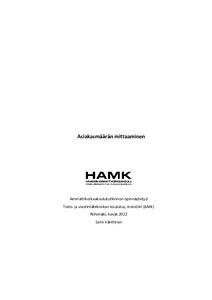Asiakasmäärän mittaaminen
Vänttinen, Sami (2022)
Vänttinen, Sami
2022
All rights reserved. This publication is copyrighted. You may download, display and print it for Your own personal use. Commercial use is prohibited.
Julkaisun pysyvä osoite on
https://urn.fi/URN:NBN:fi:amk-2022080319361
https://urn.fi/URN:NBN:fi:amk-2022080319361
Tiivistelmä
Opinnäytetyön tavoitteena oli tutkia erilaisia vaihtoehtoja kaupan asiakasmäärien mittaukseen sekä rakentaa konenäköön perustuva laite tuottamaan asiakasmäärädataa IoT Analytics Finlandin analytiikkapalveluiden tueksi.
Kauppojen asiakasmäärät mitataan tyypillisesti ulko-ovilta, mikä mahdollistaa yleisen ymmärryksen asiakasmääristä, sekä asiakasmääristä kulkuaukoilta. Kun halutaan parempi ymmärrys asiakkaiden ostoskäyttäytymisestä ja liiketilojen käytöstä, siihen tarvitaan mittaustapoja, joilla voidaan kattaa suurempia alueita. Nykypäivänä konenäkösovellukset ovat kustannustehokas tapa toteuttaa tämä mittaus.
Työssä testattiin erilaisia konenäköalgoritmeja ja kameroita, joista voi valita tarkoitukseen soveltuvat mallit, sekä verkkolaitteet, joiden avulla data voidaan tarvittaessa siirtää haluttuun palveluun. Laskentayksikkönä käytettiin Raspberry Pi4 -tietokonetta, joka on kelvollinen laite protoiluun, mutta jää laskentatehossa esimerkiksi NVIDIAn laitteille, jotka on kehitetty konenäkösovelluksiin.
Vaatimattomasta laskentatehosta huolimatta Raspberry Pi4 oli riittävän tehokas suoriutumaan henkilömäärämittauksesta, sillä tiedon päivitystarve on harva. Rakennetun laitteen tarkkuus yllätti positiivisesti, sillä laite pystyi tunnistamaan henkilöt, vaikka he olivatkin suurelta osin katveessa.
Työssä käytetyn kokoonpanon avulla voidaan projektinomaisesti tutkia henkilömääriä hyvin pienellä investoinnilla ja mahdollinen laitteen monistaminen tapahtuu SD-muistin kopiolla. Laitteen koko on myös huomaamattoman pieni. Toki laite on harraste- tai protoilutasoa, mutta toiminnallisuus on sama kuin vartavasten käyttöön suunnitelluilla laitteilla. The aim of the thesis was to study different alternatives for measuring the number of customers in retail and to build a device based on computer vision to produce customer volume data to support IoT Analytics Finland’s analytical services. IoT Analytics Finland is the commissioner of the thesis.
In the retail industry, the number of customers is typically measured from the front doors, which allows a general understanding of the customer traffic, as well as the quantities from the access openings. When a better understanding of customers' shopping behavior and the use of retail space is required, measurement methods are needed to cover larger areas. In the 2020s, machine vision applications are a cost-effective way to implement this measurement.
Various machine vision algorithms and cameras were tested in the thesis, from which suitable models can be selected, as well as network devices that can be used to transfer data to the desired service, if necessary. The Raspberry Pi4 computer was used as the computing unit, which is a valid device for prototyping, but lagging in computing power for NVIDIA devices, which are developed for machine vision applications, for example.
Despite the modest computing power, the Raspberry Pi4 was powerful enough to perform a headcount measurement when the need to update data is rare. The accuracy of the built device was a positive surprise, as the device was able to identify people even though they were largely obscured.
With the configuration used in the work, the number of people can be studied project-like with a very small investment and the possible duplication of the device would take place with a copy of the SD memory. The size of the device is also inconspicuously small. The device is suitable for prototyping, but the functionality is the same as devices designed for use.
Kauppojen asiakasmäärät mitataan tyypillisesti ulko-ovilta, mikä mahdollistaa yleisen ymmärryksen asiakasmääristä, sekä asiakasmääristä kulkuaukoilta. Kun halutaan parempi ymmärrys asiakkaiden ostoskäyttäytymisestä ja liiketilojen käytöstä, siihen tarvitaan mittaustapoja, joilla voidaan kattaa suurempia alueita. Nykypäivänä konenäkösovellukset ovat kustannustehokas tapa toteuttaa tämä mittaus.
Työssä testattiin erilaisia konenäköalgoritmeja ja kameroita, joista voi valita tarkoitukseen soveltuvat mallit, sekä verkkolaitteet, joiden avulla data voidaan tarvittaessa siirtää haluttuun palveluun. Laskentayksikkönä käytettiin Raspberry Pi4 -tietokonetta, joka on kelvollinen laite protoiluun, mutta jää laskentatehossa esimerkiksi NVIDIAn laitteille, jotka on kehitetty konenäkösovelluksiin.
Vaatimattomasta laskentatehosta huolimatta Raspberry Pi4 oli riittävän tehokas suoriutumaan henkilömäärämittauksesta, sillä tiedon päivitystarve on harva. Rakennetun laitteen tarkkuus yllätti positiivisesti, sillä laite pystyi tunnistamaan henkilöt, vaikka he olivatkin suurelta osin katveessa.
Työssä käytetyn kokoonpanon avulla voidaan projektinomaisesti tutkia henkilömääriä hyvin pienellä investoinnilla ja mahdollinen laitteen monistaminen tapahtuu SD-muistin kopiolla. Laitteen koko on myös huomaamattoman pieni. Toki laite on harraste- tai protoilutasoa, mutta toiminnallisuus on sama kuin vartavasten käyttöön suunnitelluilla laitteilla.
In the retail industry, the number of customers is typically measured from the front doors, which allows a general understanding of the customer traffic, as well as the quantities from the access openings. When a better understanding of customers' shopping behavior and the use of retail space is required, measurement methods are needed to cover larger areas. In the 2020s, machine vision applications are a cost-effective way to implement this measurement.
Various machine vision algorithms and cameras were tested in the thesis, from which suitable models can be selected, as well as network devices that can be used to transfer data to the desired service, if necessary. The Raspberry Pi4 computer was used as the computing unit, which is a valid device for prototyping, but lagging in computing power for NVIDIA devices, which are developed for machine vision applications, for example.
Despite the modest computing power, the Raspberry Pi4 was powerful enough to perform a headcount measurement when the need to update data is rare. The accuracy of the built device was a positive surprise, as the device was able to identify people even though they were largely obscured.
With the configuration used in the work, the number of people can be studied project-like with a very small investment and the possible duplication of the device would take place with a copy of the SD memory. The size of the device is also inconspicuously small. The device is suitable for prototyping, but the functionality is the same as devices designed for use.
